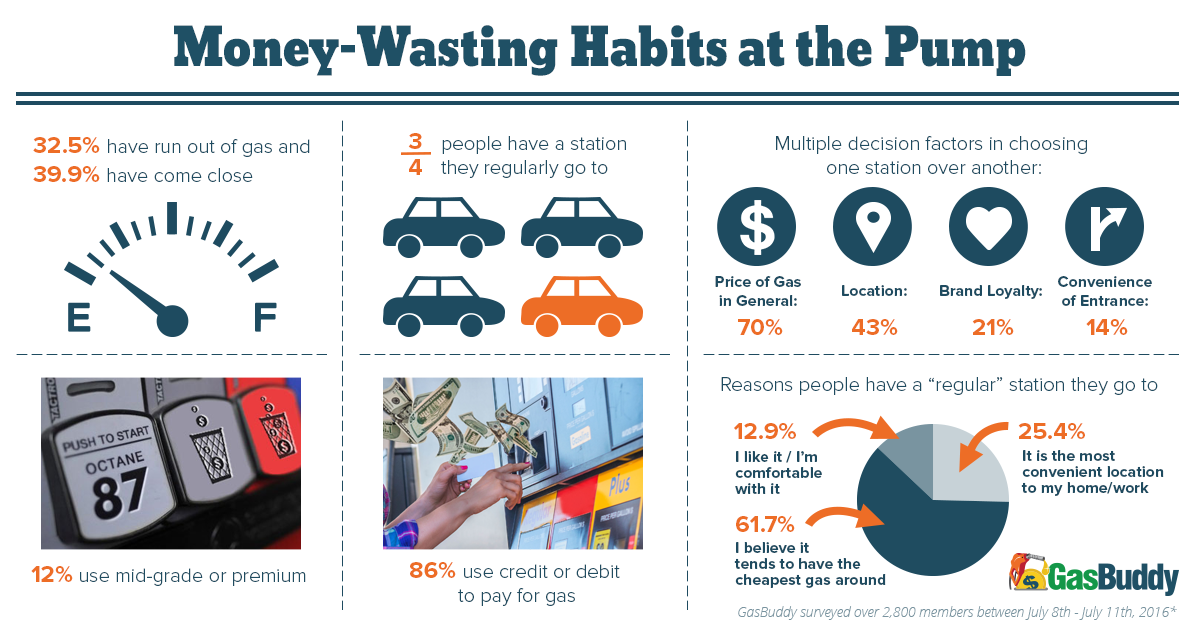Five things consumers are regularly doing that are costing them extra at the pump.
BOSTON (Aug 2, 2016) - GasBuddy today announced the findings of its survey on American motorists’ fuel-purchasing habits, revealing we are prone to overpaying at the pump due to several key factors: procrastination, craving convenience and being creatures of habit.
According to the U.S. Energy Information Administration, the average vehicle travels 33 miles a day, which means weekly stops at the pump for most. With visits to the gas station being such a common occurrence, GasBuddy conducted a survey to glean further insights on how consumers decide where and when to stop for fuel, and explain how these decisions could be costing you.
Here are the five things drivers are doing that’s costing them extra at the pump:
1. Being Creatures of Habit
About 76% of respondents said they have a station they regularly go to, either because its location is convenient (25%) or because they believe it tends to have the cheapest price (62%). However, that isn’t always necessarily the case.
“Make sure you’re shopping smart and checking that your go-to fill-up spot is, in fact, the cheapest,” said Vera Gibbons, senior consumer analyst at GasBuddy. “You never know when a nearby station is running a promotion or may have changed their pricing strategy, so always double-check.”
2. Running on Empty
Another money-drain is waiting too long to get gas. Only 21.7% of people decide to fill up when they see a station with a good price, with most (38.1%) waiting until they only have a quarter tank left of gas, while 19% wait until the gas light comes on.
“If you’re waiting until the last second to get gas, you’re most likely going to pull into the first station you see without checking a price and risk filling up at an expensive station,” said Gibbons. “According to our research, most people can save around 20-30 cents per gallon by shopping around for the cheapest station within a city. In some cities like Chicago, Los Angeles, Seattle and Washington, D.C., the savings could be upwards of 70 cents per gallon.”
3. Choosing the Easy Route
Consumers are paying for convenience and not planning ahead; 40% of respondents choose a gas station based on location, while 14% choose a station depending on ease of entrance.
4. Paying with Plastic
The method you pay for gasoline matters to your wallet too; 86% of people use a credit or debit card to pay at the pump rather than cash.
“A growing number of stations are offering a cash discount, where on average you could save 10-15 cents per gallon on your fill-up,” said Gibbons. “Paying with cash might be less convenient for those who only carry cards, but it’s a simple way to save some extra money.”
Gibbons also notes that some credit cards (whether gas specific cards or cash back) offer an attractive rebate when used on gas purchases. Bottom line: If you’re paying with a credit card, make sure it’s the right card. Research your options on a site like lowcards.com
5. Mistaking Your Grades
While gas prices remain historically low, the cost difference between regular and premium gas has increased over the past year. According to the survey, 12% of the respondents said they use the more expensive mid-grade or premium fuel instead of regular.
“Many cars run smoothly on regular gasoline,” said Gibbons. “You only have to use premium if your car manual says it’s required, not if it’s just recommended.”

